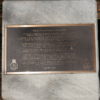The South Australian Dam Busters memorial was dedicated on 17th May 2008 in dedication to the three South Australian Airmen involved in the WWII Dam Busters Raid. 133 Aircrew were involved in this raid including thirteen Australian with the sole aim of destroying dams that were marked as strategically improtant in the industrialised Ruhr Valley, Germany. The three South Australians involved in this raid were Squadron Leader David Shannon, Flight Lieutenant Robert Hay and Flying Officer Frederick Spafford. Out of these three men, only Squadron Leader David Shannon survived the events of the war. Their efforts, along with their comrades, were not only well recognised but played a crucial role in increasing morale and weakening German war-time production.
1943 Dam Buster Raid
Key strategic targets such as the Mohre, Eder and Sorpe Dams in the Ruhr Valley were already identified by the British Air Ministry prior to the Second World War. It was clear to the military that the destruction of these dams would impede the canal transport system and destroy a source of hydroelectic power and pure drinking water which was also utilized for steel production. By marking these dams as potential targets, the intent was to therefore disrupt the German war production and hinder a strategic industrial zone. While a surprise attack was needed to ensure the effective destruction of these targets, the dams were well protected by anti-aircraft guns and under-water torpedo nets. A suitable weapon was therefore needed in the event of a bombing raid on this location.
The secret weapon was designed by Dr Banes Wallis, the assistant chief designer at the Vickers Aircraft Company, under the codename ‘highball’. The weapon – a rotating cyclindrial device designed to bounce over torpedo nets, roll below the dams exterior and destroy its base. With the weapon designed, the Allies formed a squadron in March 1943 comprised of aircrew from Australia, Britain, Canada, USA and New Zealand. Shortly after their formation, the squadron began low-level flight training at night in preparation for the raid codenamed Operation Chastise. The training was undertaken in modified Avro Lancasters Mk III’s which were stripped of armour to reduce weight and allow space for the ‘bouncing bomb’. Operation Chastise began two months later on the evening of 16 May 1943. With a crew of 133 in 19 Lancasters, the squadron departed England to attack the main targets of the Mohne, Eder and Sorpe Dams.
The raids oversaw the successful destruction of both the Mohne and Eder Dams, two hydroelectric power stations as well as the damage of several factories, mines and other hydroelectric power stations. While the Sorpe Dam only sustained minor damage, the breaching of both the Mohne and Eder caused catastrophic damage to the Ruhr Valley as well as a significant morale boost to the Allies. During the outcome of the raids, 53 aircrew in 617 Squadron were killed and another three were captured and made prisoners of war. It has been estimated that roughly 1,650 people were killed in the raid, over 1,000 being forced labourers and prisoners of war made to work in the industrial mines and factories.







Comments